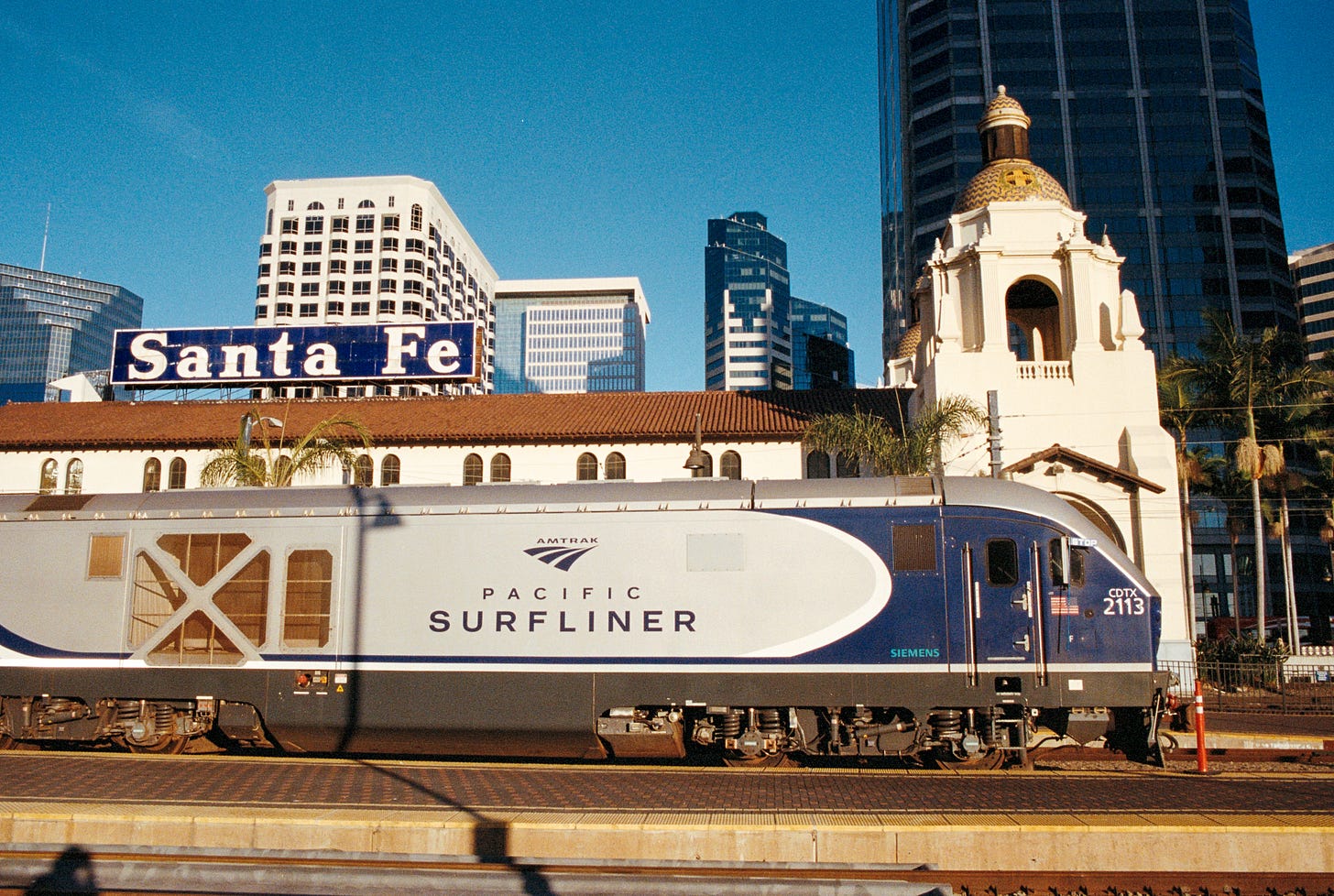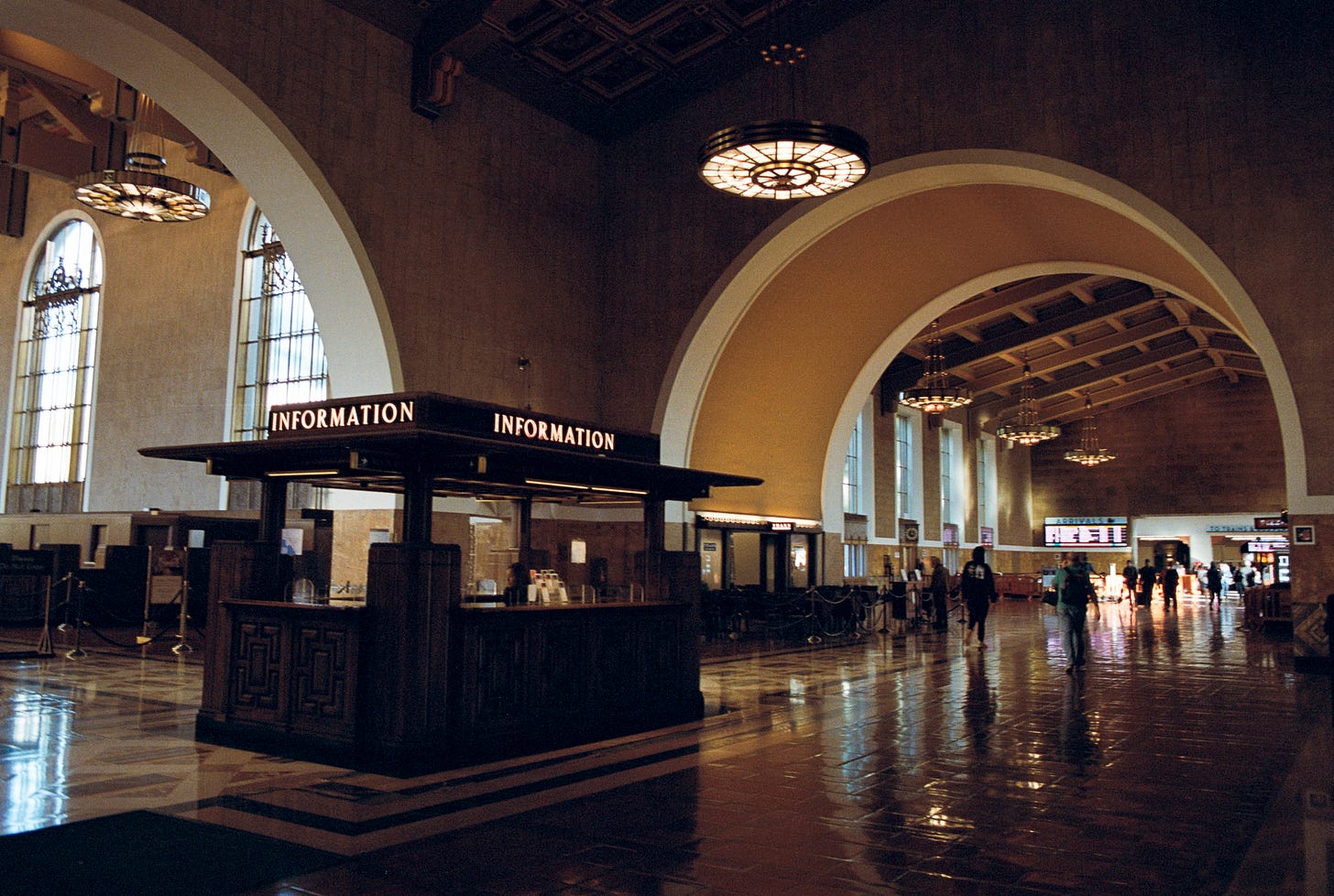This week I wanted to share some travel tips from my home state of California. I recently collaborated with Visit California on a concept I’ve wanted to bring to life for years - #CarlessCalifornia.
Ever since I was a little kid I’ve been fascinated by the faint traces of early California hidden in the midst of modern suburbia. A phantom railway track leading nowhere. Old photos of street cars plying my neighborhood’s main boulevard.
Each discovery became like a clue, a string I tugged to reveal an older California stitched together by indigenous trading routes, Spanish missionaries and the iron railways of a confident and expansive industrial-age America.
Trains are not usually something we associate with California, but my student days led me to commute by train quite frequently. I grew enamored with our cities’ overlooked train stations and the dense urban wonderlands that grew up around them - only to be forgotten with the rise of the automobile.
But with the climate crisis ever present and the war in Ukraine spiking gas prices, I felt it was the perfect time to share an itinerary long in the making - how to travel California without a car. The state tourism board agreed, and last fall we shot this fun and informative series in San Diego, LA and Santa Barbara.
Note: although a mudslide took out the tracks between San Diego and LA, they are working to reopen the route soon. And although we had to drive that one section, this itinerary remains an evergreen guide to the Golden State.
See the videos and detailed notes below - and feel free to share with your friends!
Safe travels,
Marko
San Diego
We based ourselves in San Diego’s Gaslamp Quarter, near Santa Fe Station. Growing up, I was fascinated by the city’s early public transportation system, which linked the downtown core with the suburbs surrounding Balboa Park via a system of street cars (the remants of which can still be seen at the end of the old line in Adams Avenue).
As in many American cities, the street cars were bought up by car companies and ripped out to force consumers to “modernize” and buy automobilies. But the wide boulevards remain and the central core of the city is still an ideal medium density area to explore by ride sharing or grab-and-go bikes and scooters.
We stayed in the central Sofia Hotel on Broadway and explored the following:
Balboa Park - The heart of historic San Diego was built around this 1200 acre park which was built for the 1915 Panama-American Fair to celebrate the opening of the Panama Canal. Today it’s full of museums (many are are free on Tuesdays), such as the Mingei, Timken, and the Museum of Us. And don’t miss the Botanical Gardens once it reopens after rennovations.
Little Italy - the former tuna capital of the world is now a trendy walkable neighborhood accessible by light rail. I sampled local beer at Bottlecraft tap room, but my favorite bar is the Waterfront - San Diego’s oldest tavern.
South Park / Golden Hill - For lunch, I took Deshlee to the death-metal-vegan-cocktail restaurant Kindred for one of my favorite vegan meals. Then I cooked myself a marinated steak with a martini in hand at the Turf Supper Club.
Barrio Logan - we dropped into the new Chicano Park Museum, which tells the story of how the neighborhood birthed the largest collection of chicano murals on earth. Down the street is my favorite Mexican restaurant - Las Cuatro Milpas.
Pacific Beach - I can’t visit San Diego without having breakfast on Crystal Pier at my favorite spot - Kono’s Cafe. Order the Big Breakfast and snag a table overlooking the ocean.
Old Town - After exploring the birthplace of Spanish San Diego, we ate birria bone marrow tacos at Tuetano Taqueria followed by a dinner of mole with a mezcal sampling at Tahona Bar (ask about booking a table at their speakeasy).
Finally, check out of your hotel and return to Santa Fe Depot to catch the Surfliner north to LA. Grab a seat on the left side for the ocean view and consider stopping in Encinitas to see the more mellow surf town vibe of North County.
Los Angeles
Ever since watching the classic film Chinatown I’ve been mildly obsessed with 1930s Los Angeles, which thrived in what is now considered East LA. Despite decades of neglect, DTLA is finally getting the recognition it deserves, with world-class restaurants and hotels opening to offer visitors an alternative to the West Side image most associate with LA. Here’s my guide to the Downtown Core:
Union Station - the 1930s masterpiece of railway terminal design. Don’t miss its hidden cocktail bar just to the right of the entrance, called Traxx.
Stay in the Freehand Hotel, a mini chain of upscale hostels with their excellent rooftop cocktail bar, the Broken Shaker.
Olvera Street - the original Mexican settlement, which includes the oldest extant home in all of Los Angeles, the Avila Adobe.
Little Tokyo - once the largest Japanese community in the US, after the San Francisco earthquake caused many to move south - until WWII, when many Japanese Americans were sent to Manzanar internment camp. The neighborhood was indelibly changed, but it is still vibrant and includes many third-generation businesses including Fugetsu-Do Bakery, Anzen Hardware, Bunkado and Mitsuru Cafe.
Arts District - Just down the road is an area full of galleries, boutiques and restaurants known as the Arts District. We popped into a few galleries, including the famous Hauser & Wirth and the Anna Zorina Gallery.
Theater District - We wandered the formerly opulent Theater District in search of Art Deco gems hidden in plain sight. My favorite was the gorgeous turqouise-blue Eastern Columbia Lofts and the Orpheum Theatre down the street.
Grand Central Market is a bustling food hall, and Eggslut is one of the best places in the area for breakfast. Grab one of their famous cheesy egg sandwiches before crossing the street to the iconic Bradbury Building, the oldest commercial building in LA and a star of many films. Then take the Angels Flight Railway, the shortest railway in the world built in 1901.
Finish in Chinatown for dinner and drinks. The Far East Plaza is the best one-stop shop for newer, more trendy options, the most famous of which is Howlin’ Ray’s famous chicken sandwiches. But also note Lasita Rotisserie & Natural Wine bar. But there are also some older unfussed options in Chinatown Central Plaza, which is also home to General Lee’s cocktail bar.
Santa Barbara
We finished our trip in Santa Barbara, sometimes called the California Riviera. Santa Barbara’s train station is next to the coast in an area called the Funk Zone. We stayed at the Hotel Mar Monte, on the ocean but within striking distance of downtown.
We finished our trip in Santa Barbara, sometimes called the California Riviera. Santa Barbara’s train station is next to the coast in an area called the Funk Zone. We stayed at the Hotel Mar Monte, from where we could get around mostly by foot.
Here’s the list of places featured in the video:
We did a sunset wine tasting at Deep Sea Tasting Room on Stern’s Pier, operated by Conway Family Wines. Can’t recommend this enough. First come, first serve.
Then we walked to The Lark for a dinner at the legendary farm-to-table restaurant that put the Funk Zone on the map. California Cuisine at its best.
The next morning, we grabbed coffee and breakfast burritos (for me) at Dart Coffee and a vegan breakfast for Deshlee at Tyger Tyger. Get the food to go an eat it in their shared garden space across the street.
We went shopping at a great store called The Shopkeepers, a local outpost of the surf shop Mollusk, and went thrifting at The Vintage Fox.
Then we walked up State Street and into downtown SB to visit the Presidio, built by the Spanish in 1782. It’s a great place to learn about the history of Spanish Santa Barbara.
For lunch, make a pilgrimage to the Cold Spring Tavern, a former stagecoach stop built in 1868, famous for its tri-tip sandwiches
We returned to town to catch the sunset at the Old Mission Santa Barbara, the only continuously operating mission in California often called “The Queen of the Missions.” It holds mass led by a priest in the typical habit of the Franciscans.
Finally, finish with a night out on State Street, the heart of nightlife. Grab a lobster roll at Broad Street Oyster Company, drink local mead at Wylde Works and play arcade games over drinks at The Cruisery.
Would You Do It?
That’s my guide to seeing California without a car. Would you attempt it yourself?
Add your own California and train-travel tips below and let me know where else you would visit by train!
PS: If you want to join our monthly book club discussion, see the following post for more info about this month’s book and how to join the live Zoom chat.












I have travelled from San Jose to Davis before by train, through the wildlife reserve of the Bay. It was amazing! I lived in California a couple years, and never had a car, so this post is awesome!
That so many American cities tore out their tram systems is such a travesty...